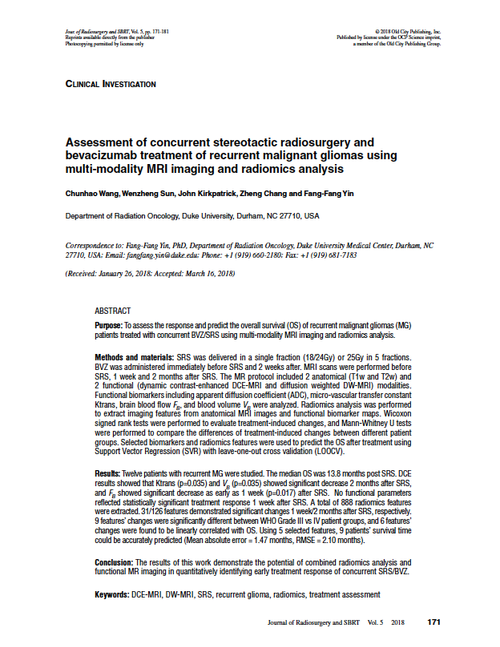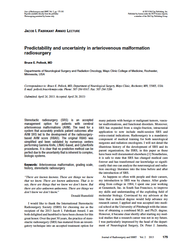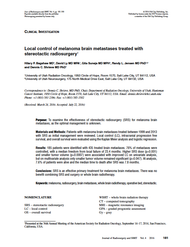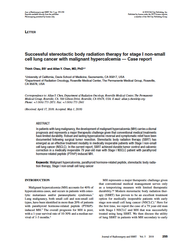- Home
- Journal Contents Downloads
- JRSBRT Downloads
- JRSBRT 5.3, p. 171-181
Product Description
Assessment of concurrent stereotactic radiosurgery and bevacizumab treatment of recurrent malignant gliomas using multi-modality MRI imaging and radiomics analysis
Chunhao Wang, Wenzheng Sun, John Kirkpatrick, Zheng Chang and Fang-Fang Yin
Purpose: To assess the response and predict the overall survival (OS) of recurrent malignant gliomas (MG) patients treated with concurrent BVZ/SRS using multi-modality MRI imaging and radiomics analysis.
Methods and materials: SRS was delivered in a single fraction (18/24Gy) or 25Gy in 5 fractions. BVZ was administered immediately before SRS and 2 weeks after. MRI scans were performed before SRS, 1 week and 2 months after SRS. The MR protocol included 2 anatomical (T1w and T2w) and 2 functional (dynamic contrast-enhanced DCE-MRI and diffusion weighted DW-MRI) modalities. Functional biomarkers including apparent diffusion coefficient (ADC), micro-vascular transfer constant Ktrans, brain blood flow FB, and blood volume VB were analyzed. Radiomics analysis was performed to extract imaging features from anatomical MRI images and functional biomarker maps. Wicoxon signed rank tests were performed to evaluate treatment-induced changes, and Mann-Whitney U tests were performed to compare the differences of treatment-induced changes between different patient groups. Selected biomarkers and radiomics features were used to predict the OS after treatment using Support Vector Regression (SVR) with leave-one-out cross validation (LOOCV).
Results: Twelve patients with recurrent MG were studied. The median OS was 13.8 months post SRS. DCE results showed that Ktrans (p=0.035) and VB (p=0.035) showed significant decrease 2 months after SRS, and FB showed significant decrease as early as 1 week (p=0.017) after SRS. No functional parameters reflected statistically significant treatment response 1 week after SRS. A total of 888 radiomics features were extracted. 31/126 features demonstrated significant changes 1 week/2 months after SRS, respectively. 9 features’ changes were significantly different between WHO Grade III vs IV patient groups, and 6 features’ changes were found to be linearly correlated with OS. Using 5 selected features, 9 patients’ survival time could be accurately predicted (Mean absolute error = 1.47 months, RMSE = 2.10 months).
Conclusion: The results of this work demonstrate the potential of combined radiomics analysis and functional MR imaging in quantitatively identifying early treatment response of concurrent SRS/BVZ.
Keywords: DCE-MRI, DW-MRI, SRS, recurrent glioma, radiomics, treatment assessment
After payment has been processed for your order of a digital copy (PDF) of this article, you will see a download link on your completed order page and also receive an email containing a download link. The links, which will enable you to download one copy of the article, will expire after 24 hours.
 Loading... Please wait...
Loading... Please wait...








